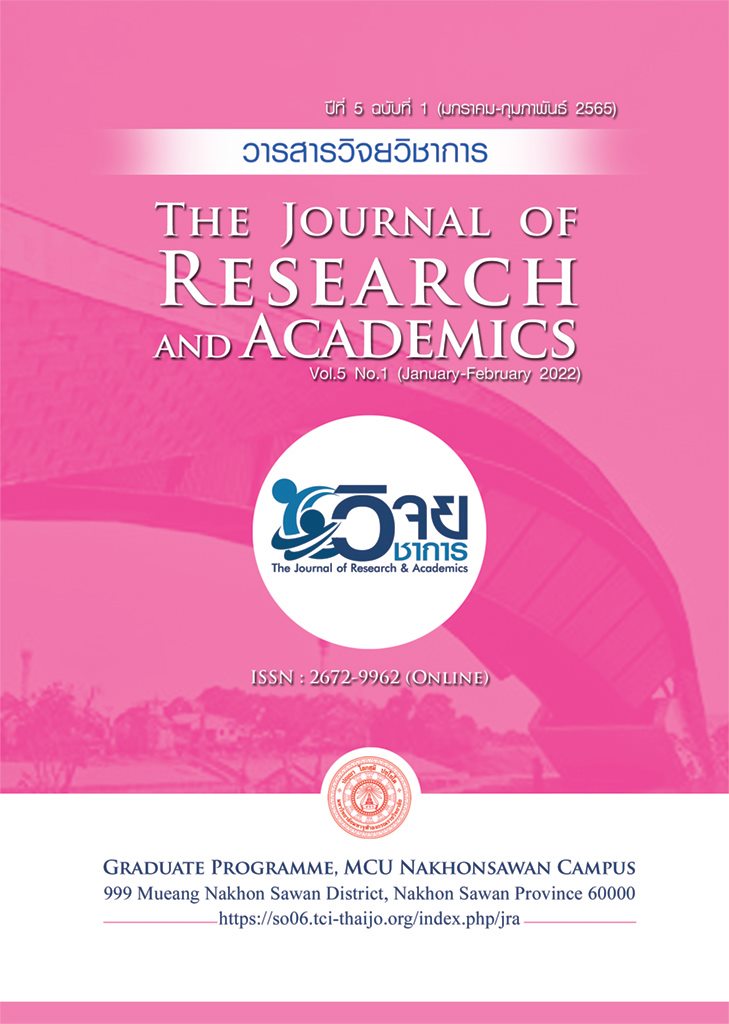ตัวชี้วัดความสำเร็จของการปฏิบัติงานนอกที่ตั้งของพนักงานในสำนักงาน ยุคปกติใหม่
Main Article Content
บทคัดย่อ
บทความวิจัยนี้มีวัตถุประสงค์เพื่อศึกษาตัวชี้วัดความสำเร็จในการปฏิบัติงานนอกที่ตั้งของกลุ่มพนักงานในสำนักงานยุคปกติใหม่ ด้วยวิธีการสุ่มอย่างง่าย โดยเลือกกลุ่มตัวอย่างแบบบังเอิญ กำหนดขนาดตัวอย่างที่ใช้ในการวิจัย 20 เท่า จากตัวแปรสังเกตได้ เครื่องมือที่ใช้เป็นแบบสอบถามออนไลน์ ที่ผ่านกระบวนการสร้างและตรวจสอบคุณภาพเครื่องมือ เพื่อให้ได้เครื่องมือคุณภาพ ได้ค่าสัมประสิทธิ์ความเที่ยง .985 และค่าความตรง .984 เก็บรวบรวมข้อมูลจากกลุ่มตัวอย่างซึ่งเป็นผู้ปฏิบัติงานในสำนักงานทั้งภาครัฐและเอกชน ได้รับคำตอบกลับคืนมา จำนวน 240 ตัวอย่าง วิเคราะห์ข้อมูลด้วยสมการโครงสร้างเชิงเส้น ผลการวิจัยพบว่า ตัวชี้วัดความสำเร็จในการปฏิบัติงานนอกที่ตั้งของกลุ่มพนักงานในสำนักงานยุคปกติใหม่ ประกอบด้วย 1) ทุนทางปัญญา ได้แก่ ทุนมนุษย์และทุนองค์การ 2) ปัจจัยในการทำงานระยะไกล ได้แก่ ทรัพยากรที่สนับสนุนและนโยบายองค์การ และ 3) เป้าหมายความสำเร็จ ได้แก่ ความสำเร็จเชิงปริมาณ ความสำเร็จเชิงคุณภาพ ความสำเร็จด้านเวลา และ ความสำเร็จด้านต้นทุนค่าใช้จ่าย มีความสอดคล้องกับวรรณกรรมและข้อมูลเชิงประจักษ์โดยมีค่า p-value = 0.043, GFI = 0.98, CFI = 0.98, NFI = 0.99, IFI = 1.00, RMSEA = 0.056, SRMR = 0.013 แสดงว่ามีความสอดคล้องกับวรรณกรรมและข้อมูลเชิงประจักษ์
Article Details

อนุญาตภายใต้เงื่อนไข Creative Commons Attribution-NonCommercial-NoDerivatives 4.0 International License.
1. เนื้อหาและข้อมูลในบทความที่ลงพิมพ์กับวารสารวิจยวิชาการ ถือเป็นข้อคิดเห็น และความรับผิดชอบของผู้เขียนบทความโดยตรงซึ่งกองบรรณาธิการวารสารไม่จำเป็นต้องเห็นด้วย หรือร่วมรับผิดชอบใด ๆ
2. บทความ ข้อมูล เนื้อหา รูปภาพ ฯลฯ ที่ได้รับการตีพิมพ์ในวารสารวิจยวิชาการ ถือเป็นลิขสิทธิ์ของวารสารวิจยวิชาการ หากบุคคลหรือหน่วยงานใดต้องการนำทั้งหมดหรือส่วนหนึ่ง ส่วนใดไปเผยแพร่ต่อหรือเพื่อการกระทำการใด ๆ จะต้องได้รับอนุญาตเป็นลายลักษณ์อักษรจากวารสารวิจยวิชาการก่อนเท่านั้น
เอกสารอ้างอิง
กัลยา วานิชบัญชา. (2557). การวิเคราะห์สถิติ/สถิติสำหรับการบริหารและวิจัย. กรุงเทพฯ: จุฬาลงกรณ์มหาวิทยาลัย.
พรเทพ ศิริวนารังสรรค์. (2563). Physical Distancing กับ Social Distancing เหมือนหรือต่างกันอย่างไร. เข้าถึงได้จาก https://covid19.thaipbs.or.th/faq/?post=23345
สำนักงานคณะกรรมการข้าราชการพลเรือน. (2563). แนวทางการให้ข้าราชการและเจ้าหน้าที่ปฏิบัติงานนอกสถานที่ตั้งของส่วนราชการ กรณีการแพร่ระบาดของโรคติดเชื้อไวรัส โคโรนา 2019 (COVID-19) ตามมติคณะรัฐมนตรี เมื่อวันที่ 17 มีนาคม 2563. เข้าถึงได้จาก https://www.ocsc.go.th/blog/2020/03
เสาวลักษณ์ แจ่มจำรุณ และนิศากร สมสุข. (2559). ปัจจัยแห่งความสำเร็จในการปฏิบัติการบินของสายการบินนกแอร์. EAU HERITAGE JOURNAL Science and Technology, 10(2), 160-174.
Alan Felstead, Nick Jewson and Sally Walters. (2003). Managerial Control of Employees Working at Home. British Journal of Industrial Relations, 41(2), 241-264.
Anderson, J. C. and Gerbing, D. W. (1988). Structural equation modeling in practice: A review and recommended two-step approach. Psychological Bulletin, 103(3), 411-423.
Anwar, M., Zaman Khan, S., and Ali Shah, S.Z. (2020). A Study of the Relationship Between Innovation and Performance Among NPOs in Pakistan. Journal of Social Service Research, 46(1), 26-40.
Beauregard, T.A., Basile, K.A., and Canonico, E. (2019). Telework: Outcomes and facilitators for employees. In R. N. Landers (Ed.), The Cambridge handbook of technology and employee behavior. Cambridge: Cambridge University Press.
Chen, M. C., Cheng, S. J. and Hwang, Y. (2005). An empirical investigation of the relationship between intellectual capital and firms’ market value and financial performance. Journal of Intellectual Capital, 6(2), 159-176.
Diamantopoulos, A. and Siguaw, J. A., (2000). Introduction to LISREL: A guide for the uninitiated. London: SAGE Publications, Inc.
Edvinsson, L., and Malone, M. S. (1997). Intellectual capital: Realizing your company's true value by finding its hidden brainpower. New York: Harper Collins.
Hair, J. F. ed al. (2010). Multivariate Data Analysis: A Global Perspective. (7thed.). Upper Saddle River, NJ: Prentice Hall.
Huang, C.J. and Liu, C.J. (2005). Exploration for the Relationship between Innovation IT and Performance. Journal of Intellectual Capital, 6(2), 237-252.
Illegems, V., Verbeke, A., and S'Jegers, R. (2001). The organizational context of teleworking implementation. Technological forecasting and social change, 68(3), 275-291.
Kianto, A., Hurmelinna-Laukkanen, P., and Ritala, P. (2010). Intellectual capital in Service and product oriented companies. Journal of Intellectual Capital, 11(3), 305-325.
Marr, B., Schiuma, G., and Neely, A. (2004). The dynamics of value creation: Mapping your intellectual performance drivers. Journal of Intellectual Capital, 5(2), 312-325.
Peterson, E. and Plowman, E.G. (1989). Business Organization and Management. Homewood, Illinois: Richard D. Irwin.
Peugh, J., and Feldon, D. F. (2020). “How Well Does Your Structural Equation Model Fit Your Data?”: Is Marcoulides and Yuan’s Equivalence Test the Answer?. CBE-Life Sciences Education, 19(es5), 1-8.
Riwo-Abudho, Njanja and Ochieng. (2013). Key success factors in airlines overcoming the challenges. New York: Kabarak University.
Schumacker, R. E. and Lomax, R. G., (2010). A beginner’s guide to structural equation modeling. (3rd ed.). New Jersey: Lawrence Erlbaum Associates.
Sydler, R., Haefliger, S., and Pruksa, R. (2014). Measuring intellectual capital with financial figures: Can we predict firm profitability?. European Management Journal, 32(2), 244-259.
Van der Meulen, N., van Baalen, P., and van Heck, E. (2014). No place like home: The effect of telework gains on knowledge worker productivity. Academy of Management Proceedings. NY: Academy of Management.
Ward, N. and Shabha, G. (2001). Teleworking: an assessment of socio-psychological factors. Facilities, 19(1/2), 61-71.


